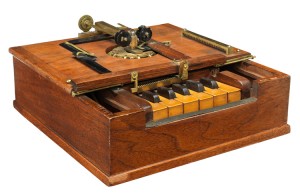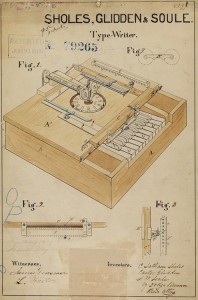Typewriter 150
Friday, June 22nd, 2018June 22, 2018
On June 23, 1868, 150 years ago tomorrow, the United States Patent Office awarded patent no. 79,265 for the world’s first typewriter. The patent went to three inventors from Milwaukee, Wisconsin: Christopher Latham Sholes, Carlos Glidden, and Samuel W. Soulé. The typewriter revolutionized business and personal communication, allowing people to write with clarity, repetition, and speed. Typewriters, of course, no longer sit on most people’s desks. But the legacy of the typewriter lives on in the keyboards of computers and smart phones as well as in the skill of typing itself.

This model of the Sholes, Glidden, and Soulé type-writer was awarded a patent 150 years ago on June 23, 1868. Credit: Smithsonian Institution
In 1867, after much trial and error, inventor and journalist Christopher Sholes designed the first practical type-writing machine. He built the first model with the help of fellow inventors Carlos Glidden and Samuel Soulé. The patented machine of 1868 used piano keys which were used in conjunction with the adjustable knob on top to produce the 26 letters—in ALL CAPS—of the English alphabet. The machine was soon fitted with a more practical keyboard consisting of buttons assigned to each letter as well as punctuation marks and a space bar. New versions also used an upright carriage, allowing users to see the words on the page as they typed. In 1873, the rights to the type-writer were sold to E. Remington and Sons, a gun manufacturer that marketed and mass-produced the new machine.

Click to view larger image
This drawing of the first typewriter accompanied the patent awarded in 1868. Credit: © Science Source
The earliest typewriters used keyboard layouts that had letters arranged alphabetically. These layouts enabled the typist to locate keys easily. However, a problem often occurred. When the typist struck in rapid succession two or more keys whose type bars were next to one another, the bars frequently jammed. To remedy this problem, Sholes helped develop another layout in the 1870′s. This layout, known as QWERTY, is still the standard for keyboards in most English- and Spanish-speaking countries. It is called QWERTY because the letters Q, W, E, R, T, and Y appear in succession near the upper left-hand corner of the keyboard. In the QWERTY layout, the bars for the letters that most often appear in combination in the English language are far apart.

Click to view larger image
A computer keyboard includes all the keys found on a typewriter, shown here in pale blue, along with other keys or groupings of keys. The top row of letters gave the QWERTY layout its name. Credit: WORLD BOOK Illustration
Keyboards in some other countries have different layouts, maximizing the use of common letters in other languages. Many French-speaking countries use the AZERTY keyboard. Germany and many central European nations have QWERTZ keyboards, and alphabets that do not use Roman characters—Arabic or Chinese, for example—have their own individual typing layouts.
The first successful portable typewriter appeared in the early 1900′s. Electric typewriters came into use in the 1920′s. The first simple word processors, then often called automatic typewriters, came into the market during the early 1960′s. Manufacturers developed the electronic typewriter during the late 1970′s. Beginning about 1980, personal computers and printers began to replace typewriters for home and office use.




